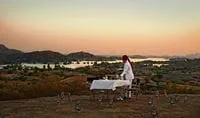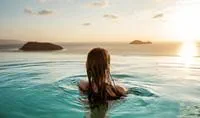Exploring the Galapagos
Katie, one of our Latin America Travel Consultants, gives her top tips of how to create an unforgettable trip to the Galapagos Islands.
19 January 2016

For anyone enchanted by wildlife there are a handful of enigmatic far flung destinations. My personal mecca has always been the Galapagos Islands, located on the Equator 600 miles west of mainland South America. Islands where animal behaviour is quite unlike anywhere else and rather than the thrill of the search as on safari, the thrill is in the interaction with wildlife that due to having no natural predators is not nervous of human presence.
Only a few of the islands are inhabited and offer accommodation for visitors so traditionally the main means of exploring the islands has been by boat. However, while for many the idea of spending time at sea is an attraction, for others the potential for choppy water and the physical limitations of being on a boat are not for them.
If you prefer not to take a boat all it, it is possible to experience the Galapagos by land only – you will only have to take a short boat ride across from Balta airport to Santa Cruz Island. On Santa Cruz, you can see the famed Galapagos sea lions, giant tortoises, pelicans, flamingos, and marine iguanas and explore the ‘Twin Craters’, signs of the islands volcanic origins.
On hearing about the recent opening of the much talked about Pikaia Lodge, which brings a third addition to the luxury accommodations available on Santa Cruz along with Finch Bay Eco Resort and the Galapagos Safari Camp, I wanted to test the waters myself and understand the difference between staying on board an expedition boat and on terra firma.
The main attraction of staying on land in a lodge, rather than on a boat, is that you can experience a greater level of comfort, space and privacy. There is a wider choice of food because even though most of the food is imported to the Galapagos, food storage can be limited on a boat. Although some of the boats are slowly implementing complimentary internet access on board (La Pinta & Silversea), due to the remoteness of some of the islands it is usually slow and involves additional cost.
The lodges can organise plentiful activities and may suit active people because you can hire or borrow bicycles, organise longer hikes and have space to go for a run and explore independently. At Finch Bay, they have a full activity programme, including a surf school and introduction to diving courses for kids and adults.
 Galapagos giant tortoise
Galapagos giant tortoise Flamingos
Flamingos Iguanas on the beach
Iguanas on the beachThe lodges on Santa Cruz have their own boats for day trips out into the National Park and you can even book the lodges in conjunction with a set activity programme to go out and visit the islands, much like you would on a cruise. There are four main islands that can be visited by day boats, the furthest being Bartolome which is 2.5 hours each way. Pikaia lodge and Finch Bay have their own day boats, however it’s important to be aware that the Galapagos National Park only licences seven day boats to minimise the environmental impact and stress on the wildlife and so the timings of the day trips are fixed. Therefore we always recommend pre-booking your day trips with us, or we can advise on packages ranging from three to five nights so that you make the most of your Galapagos adventure.
Guests at the quirky Galapagos Safari Camp have the choice of two day boats which gives them slightly more choice and flexibility. On a day trip you have lunch on board and there’s almost always a chance to snorkel with wildlife, whether it’s a penguin or a turtle, it is the most extraordinary experience!
The majority of guests however opt to take a cruise in the Galapagos, because it allows for the most coverage of the islands and the boat can move from site to site while you’re enjoying lunch, or sleeping at night, so it maximises your time on the islands themselves and you get to see more of the extraordinary wildlife than if based on land.
From your first panga ride (inflatable rib) to your expedition boat, your Galapagos adventure begins. You’ll then settle into your cabin, get introduced to your crew, have a safety briefing and set sail to your first point of call. Setting foot on a beach that is deserted, apart from a heap of marine iguanas piled on top of one another or a sea lion dozing is a thrilling experience. The animals are so curious and friendly, it is only the brilliantly coloured Sally Lightfoot crabs that scuttle away.
Even when you’re at sea cruising between the islands you are accompanied by diving frigate birds, and when moored up at night, you’ll witness the feeding frenzy over a shoal of sardines, with pelicans, sea lions and sharks all wanting in on the action – there is always something fantastic to see.
Although you tend to have more space when staying at a hotel, the newer expedition boats that cruise the Galapagos have been designed with the islands and comfort in mind so even a smaller single hull boat such as the Galapagos Sea Star Journey features huge cabins and lots of deck space. Other spacious small boats include the catamarans such as the Athala and Oceanspray who are almost as wide as they are long, offering lots of indoor and outdoor space.
These smaller boats feel intimate and mean that with less guests you can get on and off the islands quickly. However, for added stability of a larger boat, more guides and a chance to mix with a wider range of people (or not if you chose), the midsize boats such as La Pinta, Isabela II or the Silversea are great options. For families, a larger ship such as the Santa Cruz II is also a good option, the boat offers a great choice of connecting cabins and plenty of great indoor and outdoor living space to hang out, which works well for kids and teenagers. Whichever your choice of boat, the naturalist guides aboard will be on hand to bring these incredible islands to life and activities range from kayaking, snorkelling, hiking, glass bottomed boats (for non-swimmers) to diving if on a specialised cruise.
Days are much like a safari – mornings tend to start with an early breakfast before visiting a visitors site for a couple of hours, then there’s usually time for a good snorkel before some lunch and a rest before your afternoon adventure. Divers will need to book a live-aboard or extend their stay in Santa Cruz. Some cruises have great children’s programmes, from spending time with the boat captain, to football and a bbq in the highlands, the cruise is sure to be a memorable and educational adventure for the kids.
Ultimately, my conclusion is that you will get to interact with and see a greater variety of wildlife by staying on board a boat as you can cover so many more of the islands. Even on a shorter 4-night cruise, you will be able to explore islands that the lodge day boats simply can’t get to. The true perk is waking up each morning, perfectly positioned for your next awe-inspiring activity. Having said that, if a cruise simply isn’t for you, the packages at Finch Bay and Galapagos Safari camp will still ensure you experience the best of the famed Galapagos wildlife and all the comfort of a hotel. The day boats will still be bumpy boats as they are smaller, but some will prefer this way of exploring, as opposed to being on a boat permanently. If sea sickness is your concern, the calmest waters are between January and May. Whatever your preference, when you play with a sea lion while snorkelling, get followed by an inquisitive juvenile Nazca Boobie bird or meet a 80 year old giant tortoise, the Galapagos islands are simply an unforgettable experience.
For more information, fill out our enquiry form to talk to one of our Travel Consultants
This entry was posted in and tagged Couple's Holiday, wildlife.
Other blogs you may also be interested in...
Why Scott Dunn?
Unique to You

- We listen to your travel goals and craft unique trips that are bespoke to you.
- We’re with you every step of your life’s travel journey, from honeymoons to family trips and beyond.
Seamless Service

- Global offices in the UK, US, and Singapore for 24/7 seamless service.
- We offer flexibility if your plans change so you can book with confidence and peace of mind.
Carefully Curated Collection

- We’ve curated an elevated collection of accommodation, experiences, and guides.
- Committed to fostering close global relationships to continue bringing you unique experiences.
Luxury in Every Sense

- We deliver a sense of luxury that matters most to you.
- Awarded Condé Nast Traveller’s Top Travel Specialists in the World 12 years in a row.





